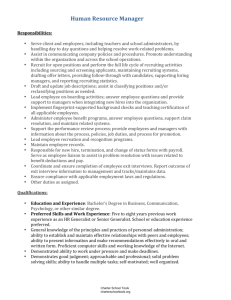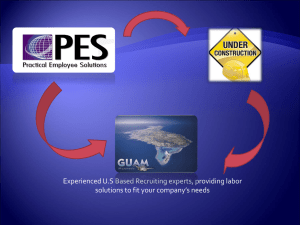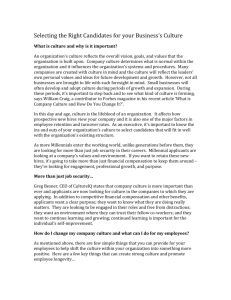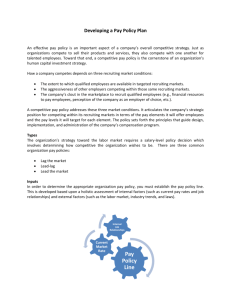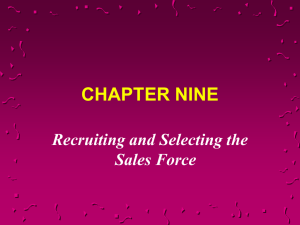How to Recruit the Best Hourly Employees
advertisement
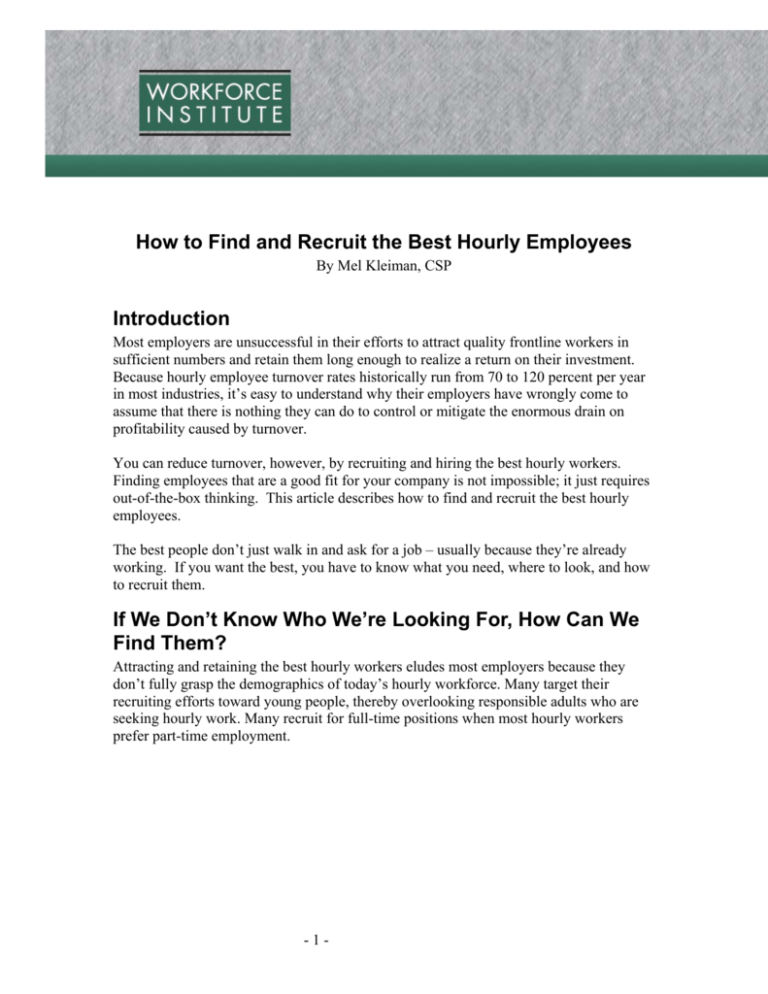
How to Find and Recruit the Best Hourly Employees By Mel Kleiman, CSP Introduction Most employers are unsuccessful in their efforts to attract quality frontline workers in sufficient numbers and retain them long enough to realize a return on their investment. Because hourly employee turnover rates historically run from 70 to 120 percent per year in most industries, it’s easy to understand why their employers have wrongly come to assume that there is nothing they can do to control or mitigate the enormous drain on profitability caused by turnover. You can reduce turnover, however, by recruiting and hiring the best hourly workers. Finding employees that are a good fit for your company is not impossible; it just requires out-of-the-box thinking. This article describes how to find and recruit the best hourly employees. The best people don’t just walk in and ask for a job – usually because they’re already working. If you want the best, you have to know what you need, where to look, and how to recruit them. If We Don’t Know Who We’re Looking For, How Can We Find Them? Attracting and retaining the best hourly workers eludes most employers because they don’t fully grasp the demographics of today’s hourly workforce. Many target their recruiting efforts toward young people, thereby overlooking responsible adults who are seeking hourly work. Many recruit for full-time positions when most hourly workers prefer part-time employment. -1- If the statistics 1 below surprise you, you don’t know today’s hourly labor pool! • While it’s no surprise that 39 percent of hourly employees are under 25 years old, did you know that 33 percent are 25-44 years old and a full 28 percent are 45 or older? • More than 80 percent work within a five-mile radius of their homes • Over half (56 percent) consider their jobs a full-time career • The vast majority (74 percent) prefer to work 30 or fewer hours a week • Most apply for three jobs at once, making employer responsiveness critical in recruiting • The most important factors to these jobseekers are: (1) Being hired quickly (37 percent) (2) Pay (33 percent) (3) Being close to home (17 percent) Another major mistake that employers make when they seek hourly employees is that they focus their energies on finding people who are currently unemployed and available to work rather than on top performers who are already working and would be open to a better job. Step-by-step Solution The following suggestions comprise a step-by-step system to hire the best employees to revitalize any hourly employee recruiting program, reduce turnover, and improve profits. Alternatives to Hiring First ask if there are alternatives to hiring. In most cases, employers start recruiting because a position is vacant or growth dictates an increase in the number of positions. Perhaps you can restructure the job or even eliminate it. • • • Seek alternatives to permanent, full-time workers: Perhaps other employees can do this job. Assign all or parts of it to existing employees, use temporary employees, and look at job sharing and cross-training as possible alternatives to hiring a permanent, full-time worker. Automate processes: The introduction of new technology sometimes allows you to change the nature of hourly jobs. For example, scanners at grocery stores eliminated the need for cashiers to know prices. Do your research to see if technology is available that would automate parts of the process. Change the business process: Jobs can be redesigned or eliminated by changing the business process involved. For example, many quick-serve restaurants now have self-serve beverage stands because it’s cheaper to offer free refills than to hire the extra help required to operate behind-the-counter beverage dispensers. 1 Sources: comScore Media Metrix, 2007; U.S. Bureau of Labor Statistics; CIBC World Markets; Borrell Associates. -2- The Job Description Recruiting hourly employees is easier and more efficient when you have “a shopping list.” This list is commonly known as a job description, and it specifies the key attributes the ideal jobholder will possess. Looking for an employee without knowing exactly what you need is like going grocery shopping without a list. You spend more time and money than you should, you don’t get everything that you need (while simultaneously splurging on things that you don’t really need), and you usually have to go back and do it again. The job description helps you avoid getting more or less than you need and wasting time and money on unqualified applicants. It is also a useful legal document. A written job description that lists the mental and physical capacities required and why the job exists is the best defense against claims of discrimination under the Americans with Disabilities Act. Job Analysis If the job description is a grocery list, a job analysis is a recipe. Designed for real (rather than government) use, this document directly reflects the job today and its potential for the future. An effective job analysis starts with the reasons the job exists (why it’s essential to the company) and the objectives of the job. It then lists the responsibilities of the jobholder. When writing the job analysis, don’t assume that the job must be done exactly as it has been done in the past. Get input and opinions from employees, supervisors, customers, and others who interface with the position. To brainstorm this list, consider: • What the jobholder must do well in order to earn a raise • Why you would reprimand or fire a person in this job • What the last jobholder did well and poorly • What you’d like to see done differently • What has kept jobholders from being successful in the past Make the analysis specific to the site and to the shift being worked, because different conditions require different qualities and abilities. Distill the essential job functions and critical requirements and the detailed profile of the qualities and abilities best suited for the job, using the CAPS approach described below. Once created, revisit the job analysis every time you hire for that position. Review it to ensure it’s current and reflects any technological, environmental, structural, or managerial changes that have occurred or are anticipated. -3- CAPS To write the job analysis, think of a job’s requirements as falling into four primary categories, easily remembered as “CAPS”: • Capacities: The mental and physical abilities required to do the job • Attitudes: Dispositions such as dependability, initiative, and customer service orientation needed for success • Personality: Temperament and traits such as competitiveness, assertiveness, and sociability • Skills: Expertise required to do the job For each category, list and then rank in order of importance the factors that would make a jobholder exceptional. Include examples and situations to illustrate when each quality is required. Capacities If an applicant lacks the required capacities, nothing else matters. That person simply cannot do this particular job. So, when creating a job analysis, the first and the most important thing to identify is the capacity requirements. There are two types of job-related capacities to consider: 1. Physical capacities: If employees will be bending, lifting, reaching, climbing, etc., indicate the nature and scope of your requirements in terms of distance, frequency, and length of time spent doing the task. Include specifics about the weights, shape, and sizes of the materials. Don’t forget to include physical capacities such as auditory and visual acuity. 2. Mental capacities: Define how much thinking and learning the job requires. Include specifics on the scope or frequency of the duty and the knowledge and abilities required for success on the job. Mental capacities might include: Understand and carry out oral and/or written instructions Read work orders, tickets, graphs, logs, or schedules Prepare detailed technical records or reports Inspect, examine, and observe product, equipment, or workmanship defects As stated earlier, the job analysis needs to be both site and shift specific. Conditions at different sites, such as size, physical barriers, and layout may require different capacities in order to perform the same job. Different shifts may require different capacities if different tasks are done at different times of day. Attitude After capacities, the most important requirement is the right attitude. 2 Where the needed capacities exist, a positive attitude will determine success on the job. Without the right 2 A substantial body of research repeatedly stresses the critical importance of a good attitude. According to the U.S. Department of Labor, more than 87 percent of employee failures are due to “an unwillingness to do the job”. Unwillingness is an attitude problem! -4- attitude, the person won’t do well, no matter how proficient their skills. In fact, it’s much easier to train an employee with a winning attitude to do the job than it is to try to train people with the right skills to smile and be pleasant if they are naturally inclined otherwise. Hire for attitude and train for skills. Employee attitudes affect every company’s success. Good employees make customers happy and grow sales. On the flip side of the coin are poor employees; they upset customers, lose sales, and compel shoppers to go elsewhere. By defining the attitudes that are most important for a jobholder’s success, you can gear your hiring efforts toward those desirable qualities. For example, an above-average hourly worker in a service industry displays these winning attitudes: • customer service orientation • team player • reliability • honesty • willingness to follows rules • problem-solving • loyalty • safety-consciousness • ability to follow through Personality It’s difficult to find an applicant with the right personality when hiring, because there are actually four personality dimensions involved. In addition to the new hire’s personality, be aware of the job’s personality, the manager’s personality, and the company’s personality. Few – if any – applicant personalities will align perfectly with the other three, but the closer the match, the better the fit. Most important is how closely the applicant’s personality matches the job. For instance, this might includes attention to detail, working with people, assertiveness, or competitiveness. People tend to do well at things that they enjoy doing and that come naturally to them. Successful people do things well, even if they don’t really like to do them, because they’re able to manage their personalities. When looking at personality, ask whether the person will manage his or her personality to get the job done. Notice the key is managing – not changing – personality to get the job done. Social scientists tell us that about 60 percent of our personality is genetic and that most personality traits are embedded by age nine. In other words, personality is part of our basic wiring; it can’t be taught and it doesn’t change much over time. Skills The ability to read is a skill; the ability to learn to read is a capacity. Employers who always put skills first when hiring make a big mistake. A person with the right capacities -5- and attitudes can be trained in the needed skills. The desired capacities and attitudes, however, can’t be taught. Remember, the preferred rule is to hire for attitude and train for skills. Of course, some jobs require a certain skill level. And frequently, there’s no time to train because you must hire immediately. In these cases, your top two priorities become capacities and skills. Skills are the easiest job requirements to identify and verify. If you need someone to drive a forklift, operate a cash register, or do data entry, you can easily test for these abilities. If you absolutely require certain skills, or if you do not plan to train new hires, then testing for required skills should take place very early in the hiring process – and always before interviews – so you don’t spend any unnecessary time with unskilled applicants. Now That We Know Who We’re Looking For, Where Do We Find Them? Armed with an understanding of hourly employee demographics, the job description, and the job analysis, we now know the qualities that define our best hourly employees. Let’s turn our attention now to where to find them. Superior performers are difficult to come by, and in most cases, they already have a job. If you want the best, you have to know where and how to look for them. Your guide in this search is the CAPS (capacity, attitude, personality, skills) job analysis. With a detailed profile of the qualities and capabilities best suited for the job, you can target your recruiting toward people with those qualifications. But traditional efforts usually won’t work. People who already have jobs don’t read help wanted ads in the newspaper or notice “Now Hiring” signs. If you want quality people, you have to use every means possible to get them to apply. Tap into new sources by directing your efforts to places where the people you want to attract are likely to be – where they congregate, socialize, go for entertainment, work, play, shop, live, get information, participate in the community, and search for common services. A comprehensive list of the best sources of new recruits is discussed later in this article. Take a Marketing Approach to Recruiting Recruiting should be an ongoing process. You should recruit new employees the same way you market to attract new customers – proactively and consistently, 24/7. If you recruit only when you have job openings, you won’t get the best people because the pressure to hire quickly causes you to be less selective and sometimes even results in a bad hiring decision. -6- Constant recruiting will result in more applicants, but remember that you want to attract large number of applicants who meet your criteria. With a greater quantity and higher quality of applicants to choose from, you’ll increase your chances of finding the best employees when you need them. Success in constant recruiting is dependent on having a good image. You need to know applicants’ perceptions of your industry, your competition, your company, and specific jobs, so you can deal with them accordingly. A marketing approach to recruiting includes being conscious of the message communicated by everything an applicant sees, including ads, application forms, and company facilities. Your company should always put its best foot forward. First impressions do matter. Make It Easy If you want to hire the best, make it easy for the best people to apply. If you accept phone calls and applications only during normal work hours, you discourage the very people you should be trying to recruit. Most people who are already working can comfortably respond only after hours. Modify your hours for accepting applications and for conducting interviews to coincide with applicant availability. Install a 24-hour job hotline and publicize it everywhere you recruit. It can be as simple as an answering machine or as sophisticated as a fully automated interviewing system. By doing this, you’ll get 30-50% more high-quality applicants. The Magnetic Company To paraphrase Yogi Berra, “If they don’t wanna work for you, nobody’s gonna stop ’em.” Companies that have a reputation for being a good place to work will always have plenty of candidates readily available and eager to work for them. Examples include Disney, Nordstrom, Southwest Airlines, UPS, The Container Store, and Proctor & Gamble. Many smaller, local companies across the country have similar reputations. In fact, being small can be an advantage. These companies can use the flexibility inherent in their smaller size to become magnets that attract good employees. How? By giving employees what they want – not in terms of the highest pay or the best benefit package, but in terms of appreciation, challenge, growth, and opportunity. Magnetic companies naturally attract, select, and retain the best because they recognize that people are important to the organization and they act accordingly. -7- Here are some examples of what magnetic companies do: • Treat employees with respect • Have clear rules and apply those rules fairly • Communicate clearly to employees • Listen to employees • Act flexibly • Give employees the tools they need to do their jobs well • Reward excellence • Make work fun • Manage people the way they want to be managed • Recognize employees’ abilities and have a plan for maximizing their potential • Do not accept mediocrity Just as you don’t always have to offer the lowest price for customers to prefer your products or services, you don’t have to pay the most to be an employer of choice. If you can apply all the rules you normally use for customer care to employee care, you’ll have what it takes to become a magnetic company. The Best Recruiting Sources You might be surprised to learn that the best sources of new employees have changed very little over the past twenty-five years. In this section, we’ll discuss traditional and non-traditional approaches, and we recommend some non-traditional employee populations that you might want to consider when hiring markets are tight. Traditional Approaches Number One still is, and always has been, people you (or your employees) already know. In surveys conducted by Humetrics between February 2007 and February 2008 of over 500 hiring managers in industries as diverse as food service, manufacturing, restaurants, petroleum marketers, hospitality, home services, and agriculture, 55 percent of respondents cited referrals as their best source of new hourly employee recruits. All the cited sources stacked up as follows (multiple answers were allowed): 55% Referrals 39% Miscellaneous media 3 21% Walk-ins 21% Schools 15% Customers 14% Internet 9% Company Web site 6% Job fairs 3 A combination of location signage, billboards, newspapers, radio, and TV. -8- It’s important to note that results varied widely by industry. For example, some industries had a great deal of success with job fairs and poor results with media advertising while other industries had the opposite experience. Keep track of what works for your company. Let’s look at how to tap into a few of the most productive sources. Referrals from Former and Current Employees When employees quit to work elsewhere, they often discover that the grass isn’t greener after all. In fact, research shows that 20 to 25 percent of supervisory and managerial employees have gone back to work at a company they once left. Imagine if 20 percent of all the good people who ever left came back to work for you! You’d have instantaneously productive workers, requiring very little training to become familiar with the organization. All you have to do is ask. Shortly after a good employee leaves, just call and ask if he or she would consider returning. Even if the answer is negative, former employees can be valuable sources for referrals. Your current employees are also a good source of referrals. Employee-referred candidates are three times more likely to be a good match for the job because your employees give these candidates detailed, accurate information about the job requirements and working conditions. As a result, candidates are likely to proceed with the selection process only if they feel it’s a good fit. And because they do fit well, referral candidates who are subsequently hired are much less likely to quit or be fired within the first few months. Let your employees know that you need good people and what you’re looking for. Implement a referral incentive for employees, giving employees a choice between cash and a day off with pay. Add excitement to a referral program by making it a game (a drawing from a variety of prizes, a “wheel of fortune,” or a departmental contest). Advertising Advertising in traditional media (location signage, billboards, newspapers, radio, and TV) is still an excellent recruiting method – if it’s done correctly. The best way to determine where to spend your recruiting dollars, of course, is to try all likely sources and keep track of the results. In some locations or for certain industries, alternative newspapers may be more effective than the mainstream metropolitan paper. In light of the fact that most hourly employees work within a five mile radius of their homes, don’t underestimate the power of location signage. Radio may deliver better results than billboards or vice versa, so you must experiment. -9- Whether it’s a storefront sign or display ad in the local paper, your message needs to answer, up front, the reasons why the people you’re trying to attract would want to work for you. The headline must grab their attention. “Help Wanted” is not an enticing reason for people to work for you. Here are some headlines that work: “Nobody else gives you the opportunities we do.” “Tired of . . .?” “Turn your career around.” “Use your talent.” “You deserve the best – and so do we.” “Take the first step toward a better future.” “Starting out or starting over?” “Get in on the ground floor.” “No more rush hour blues.” On store signage, include a call to action such as “Apply inside”. Where you have more space, the rest of the ad must screen out people who are not qualified, so provide information about the salary, your drug policy, and a brief description of the job duties and responsibilities, the location, and the work hours. Remember, the goal of ad writing is to attract “a buyer.” Sell the company and job by using relevant and compelling words in the body of the ad. When describing job duties and responsibilities, use active verbs, such as “create”, “explore”, “launch”, or “specialize”. When describing the candidate, company, and job, use interesting adjectives, such as “dynamic”, “prestigious”, “versatile”, or “winning”. Make sure the message and words appeal to your target market. Include positive features and benefits from the candidate’s point of view; highlight aspects of the job that would attract superior performers. (Here’s a great example: a moving company that wanted to attract people who work out at gyms had great success with a headline that promised “Earn While You Burn”.) Continuously assess the effectiveness of your ads in attracting the type of people you want. When interviewing candidates, ask what made them respond to the ad, then use their feedback to improve future ads. Change your headlines (and store signage) frequently if you want a diverse pool of applicants from which to select. If you always run the same message, you’ll always get the same type of people. Walk-ins It’s not surprising that walk-ins are the third best source of hourly recruits given the fact that most of these employees tend to live within a five mile radius of their employer. Location signage is an obvious way to attract local recruits, but don’t overlook neighborhood posters, sandwich boards, zip code mailings, grocery store bulletin boards, local newsletters, etc. - 10 - Schools Employers who develop good relationships with local schools will routinely get the cream of the crop when it comes to job applicants. Introduce your organization to local high schools, junior colleges, and universities. Check out adult education and English as a second language classes as well as intern programs. Consider allocating part of your recruiting budget to sponsor a school event, activity, or team. Your Customers An often neglected source of candidates is your customers. They already like your product(s), your store, your location, and the people you have working for you! Reach out to them with a sign on the counter, flyers, and bag stuffers. Your employees can wear “Ask Me About This Great Place to Work” buttons to encourage customers to learn more. The Internet While this tool has tremendous potential, the fact that only 14 percent of survey respondents find it useful suggests that we’re not fully utilizing its capabilities. Part of the disconnect may be due to the fact that Internet tools deliver applicants much faster than the typical organization can respond to them. Another common criticism of Internet recruiting is that it delivers too many unqualified candidates. As a result, hiring managers can become frustrated and start to ignore all Internet applications. To avoid this, filter the applications. The easiest way to do this is to include pre-screening questions in the application process or use automated recruiting software. Here are some resources on the Internet beyond the well known job boards like Monster, CareerBuilder, and HotJobs: • State job banks (www.jobbankinfo.org) • craigslist.org (post jobs for free) • Niche job boards (snagajob.com, restaurantworker.com, allretailjobs.com, etc.) • Social networking sites (facebook.com and myspace.com, etc.) • Ask your employees and/or kids how they use the Net to find work Your Organization’s Web Site Only 9% of respondents found this tool useful. While the survey did not delve into the reasons, anecdotal evidence suggests that this might be because the application process is too impersonal, long, and cumbersome with no appreciable ROI for the applicant. The result is that many potential applicants “bail out” before completing the process. If your organization recruits and takes applications on its Web site, walk through the process yourself. If it’s frustrating, improve the process. In the meantime, consider referring potential applicants to their nearest location to apply in person. - 11 - Non-traditional Approaches To find the best, you have to use your imagination. Your competition is probably using referrals, and they’re tapping walk-in job seekers and existing customers. They probably have alliances with schools and they’re leveraging the Internet. There are additional alternatives that you can try. Here are some more great sources of applicants: • Media such as bag stuffers, payroll stuffers, church bulletins, doorknob signs, tear-off bulletin board signs, car window flyers • Referrals from vendors, churches, teachers, Goodwill, YMCA/YWCA • Associations such as trade and professional organizations and the local Chamber of Commerce • Social Groups such as bowling leagues, church groups, youth groups, condo associations, 4H, and scouting groups • Events such as job fairs, craft fairs, and community events Applicants as Sources of Recruits Professional recruiters get leads on some of their best applicants from the people they interview. You can, too. Ask every applicant you interview for the names and phone numbers of several people they’ve worked with and people they’ve worked for. Then call those they’ve worked with as personal references. This serves two purposes: You’ll probably get more honest, substantial information about the applicant’s capacities, attitudes, personality traits, and skills (CAPS) than you will from supervisory references. But you can also get information about the reference’s qualities and abilities. If you like what you hear, add the reference to your potential applicant database. When you need someone like that in the future, you can call back and say that there are new openings you thought he or she might be interested in. Recruiting Cards A great way to make recruiting an ongoing activity is to create and use a recruiting card. It looks like a business card, but has a recruiting message on it like: “Great service! We’re always looking for good employees like you.” The card invites the recipient to call for a confidential interview and includes pertinent contact information. This can be printed on the back of your regular business card or you can create a specialized card that tells potential recruits why they should call. Always carry the cards with you and give them to people who provide exceptional service or who demonstrate outstanding qualities and abilities. If possible, include a discount or giveaway offer on a product or service as an added incentive. When someone redeems a card, get the person’s name and phone number so you can add it to your database of potential applicants. - 12 - Personnel Agencies & Recruiters As long as you’re aware of their limitations, personnel agencies and recruiters can be helpful in finding applicants. However, not all of them will be as concerned as you are about making the best possible match between job and candidate. Some agencies tend to care more about sales than making the best matches. The turnover rate in the personnel agency industry is about 90 percent, so the representative servicing your account may be new to the agency or new to the business. Your contact recruiter isn’t necessarily the person who will actually do the recruiting; make sure you know who the players are. Also be aware that the lower the rate you negotiate, the less attention your account is likely to receive. Non-traditional employee targets Due to economic expansion, population shifts, and local competitors, there are sometimes more jobs available than there are people with the necessary skills to fill them. It’s time to do some out-of-the-box thinking! Here are some non-traditional groups employers should consider if traditional sources dry up: Older people: Their wealth of work and life experience usually far exceeds whatever the job requires, so you get excellent value for your money. To recruit them, go where they go – retirement communities, senior centers, volunteer organizations, the local AARP chapter, mall walking – yes, even Bingo games. Physically and mentally challenged people: It’s not only the right thing – morally and legally – to do, but it’s smart. Track records prove that physically and mentally challenged people are good workers, requiring only minimal accommodations. One source is the National Telecommuting Institute (http://www.nticentral.org). It offers nationwide training and supervision to individuals with disabilities who want to work from home, and can get workers the computer equipment and phones they need. Companies participating in the program are entitled to a federal tax credit for hiring individuals with disabilities. Welfare recipients: There’s a lot of effort aimed at employing the so-called “unemployable”. It involves more than placing people in jobs, however. Usually basic training in good work ethics is required. Most small companies can’t afford to hire, train, and assimilate people who have never worked. However, there is some incentive. The Small Business Job Protection Act of 1996 authorized the Work Opportunity Tax Credit (WOTC) Program to help move people from welfare to work. By hiring certain job seekers, employers can reduce their federal tax liability by as much as $2,100 per qualified new worker or $1,050 per qualified summer youth. If you’re interested, you can sign up online at www.sba.gov/welfare, the Small Business Administration’s Web site. Parolees: Several states will provide bond for former convicts hired and some have work-release programs that train and support parolees entering the workforce. A major drawback, however, is parolee employers have to be especially careful about negligent hiring lawsuits. - 13 - Full-time employees looking for a second job: More than seven million people in the United States hold at least two jobs at the same time. To attract people who want to work two jobs, emphasize a second income, flexible hours, and other benefits that would appeal to people working more than one job. Parents with young children: Full-time workers may be interested in reducing their hours in order to spend more time at home with their children. Emphasize flexible parttime schedules and recruit them through daycare centers near your location. Newcomers: People moving into your neighborhood may be very interested in working close to home. Even someone who was relocated by his or her employer might have a spouse who’s looking for work. Realtors and your local Welcome Wagon are great sources for these recruits. Why Bother? The Value of Recruiting the Best The goal of recruiting is to attract positive interest in your company in a cost-effective manner. You have to pitch your organization to the right type of applicant. You want to be perceived as the kind of organization that the best people want to work for. When you invest the time to do it right, the benefits of an ongoing, hourly employee recruiting program include: • Less downtime when jobs need to be filled • Saved time and money • Fewer management migraines • Lower cost per hire • Reduced turnover and increased profitability • Greater cultural diversity If you make the effort to find and recruit the best hourly employees, you will add value to the organization now and in the future because you’re recruiting the kind of people who can give you a real competitive edge. About the author Certified Speaking Professional Mel Kleiman is North America’s leading consultant, author, and speaker on strategies for hiring and retaining the best frontline, hourly employees and their managers. He is the president of Humetrics, a leading developer of systems, training processes, and tools for recruiting, selection, and retention of the hourly workforce. Mel is also the author of five books, including the best selling Hire Tough, Manage Easy. Mel is a member of the Workforce Institute’s Board of Advisors. You can reach Mel at (713) 7714401, mkleiman@humetrics.com or via www.kleimanhr.com. - 14 -
